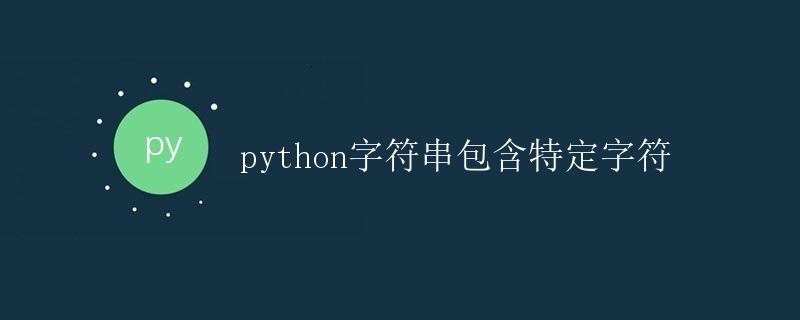Python字符串包含特定字符

在Python中,我们经常需要检查一个字符串是否包含特定的字符或子字符串。这对于数据处理、文本分析和字符串操作非常重要。本文将详细介绍如何使用Python来检查字符串是否包含特定字符。
使用in关键字检查字符串是否包含特定字符
最简单的方法是使用Python中的in关键字来检查字符串是否包含特定字符。in关键字返回一个布尔值,表示字符串是否包含指定的字符。下面是一个示例:
# 检查字符串是否包含特定字符
str1 = "Hello, World!"
char = "o"
if char in str1:
print(f"The character '{char}' is present in the string.")
else:
print(f"The character '{char}' is not present in the string.")
输出:
The character 'o' is present in the string.
在上面的示例中,我们首先定义了一个字符串str1和一个字符char。然后使用in关键字检查字符char是否包含在字符串str1中,并输出相应的结果。
使用find()方法检查字符串是否包含特定子字符串
除了使用in关键字,我们还可以使用字符串对象的find()方法来检查字符串是否包含特定的子字符串。find()方法返回匹配子字符串的第一个索引,如果找不到匹配的子字符串,则返回-1。下面是一个示例:
# 检查字符串是否包含特定子字符串
str2 = "Python is a versatile programming language."
sub_str = "is a"
if str2.find(sub_str) != -1:
print(f"The sub string '{sub_str}' is present in the string.")
else:
print(f"The sub string '{sub_str}' is not present in the string.")
输出:
The sub string 'is a' is present in the string.
在上面的示例中,我们定义了一个字符串str2和一个子字符串sub_str。然后使用find()方法来查找子字符串sub_str是否包含在字符串str2中,并输出相应的结果。
使用正则表达式检查字符串是否包含特定模式
如果我们需要更复杂的模式匹配,我们可以使用Python中的re模块来处理。re模块可以帮助我们使用正则表达式来检查字符串是否包含特定的模式。下面是一个示例:
import re
# 检查字符串是否包含特定模式
str3 = "Email me at john.doe@example.com"
pattern = r"\b[A-Za-z0-9._%+-]+@[A-Za-z0-9.-]+\.[A-Z|a-z]{2,}\b"
if re.search(pattern, str3):
print("The string contains an email address.")
else:
print("No email address found in the string.")
输出:
The string contains an email address.
在上面的示例中,我们使用正则表达式r"\b[A-Za-z0-9._%+-]+@[A-Za-z0-9.-]+\.[A-Z|a-z]{2,}\b"来匹配一个简单的电子邮件地址模式,并使用re.search()方法检查字符串str3是否包含这种模式。如果找到匹配的模式,则输出相应的结果。
总结
本文介绍了几种方法来检查Python字符串是否包含特定字符或子字符串。通过使用in关键字、find()方法和正则表达式,我们可以轻松地实现这一功能。根据不同的需求和复杂度,我们可以选择适合的方法来检查字符串中是否包含特定的内容。
 极客教程
极客教程